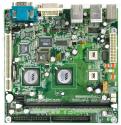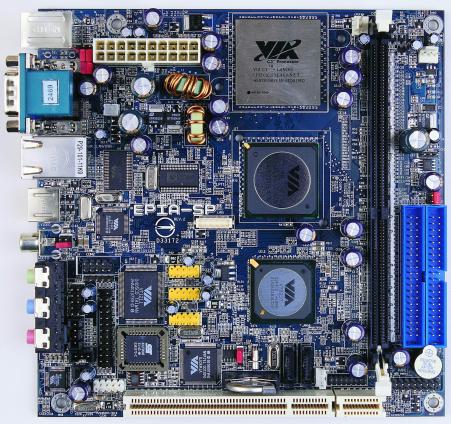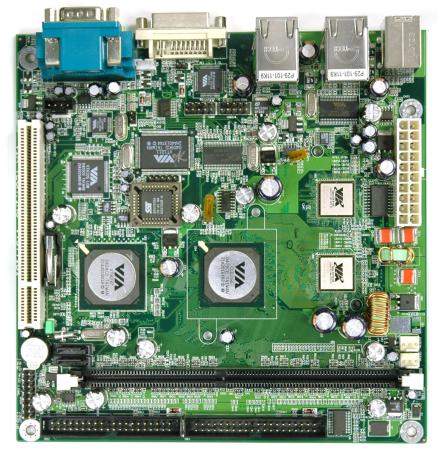World’s first dual-processor mini-ITX mobo?
Oct 6, 2004 — by LinuxDevices Staff — from the LinuxDevices Archive — 25 views Via will ship its long-awaited “SP” mini-ITX board in November, followed in early 2005 by a “DP” model with dual nanoBGA embedded processors — quite likely the world's first dual processor mini-ITX mobo. Both mini-ITX boards will feature a new northbridge supporting faster FSB (front-side bus), southbridge interconnect, and DDR memory speeds, and hardware MPEG-4 acceleration.
Via will ship its long-awaited “SP” mini-ITX board in November, followed in early 2005 by a “DP” model with dual nanoBGA embedded processors — quite likely the world's first dual processor mini-ITX mobo. Both mini-ITX boards will feature a new northbridge supporting faster FSB (front-side bus), southbridge interconnect, and DDR memory speeds, and hardware MPEG-4 acceleration.
Via originally announced the SP board in late May. The SP will be the first Via mini-ITX board available with the CN400 northbridge.
New northbridge
The CN400 replaces the Via's venerable but slow CLE266. The CN400 supports FSB (front-side bus) speeds up to 200MHz, a 1GB/s southbridge interconnect, and the ability to address up to 8GB of DDR400/333/266 RAM. The CLE266 supports FSB speeds of only 133MHz, a 266MB/s southbridge interconnect, and support for only 1GB of DDR266 RAM.
Additionally, the CN400 supports hardware MPEG-4 acceleration.

Via's SP board, with CN400 northbridge, is due in November
(Click for larger view)
Dual-processor mini-ITX?
Dual-processor mini-ITX may seem like a four-wheel-drive Hyundai, but Via's DP board is likely to cost more than most of its other mini-ITX boards. The board will use two Eden ESP processors, which cost more because they are processed and tested for high-temperature, passively cooled embedded applications before being packaged in the more expensive 15 x 15mm nano-BGA (ball-grid array) package. The Eden chips boast a TDP (thermal design power) of 7 watts, or about half that of Via's C3 desktop chips, suggesting the new DP board should work fine with commodity mini-ITX power supplies. The new northbridge, built on a 0.15µm process, could save power compared to the CLE266, too.
Via platform marketing manager Tim Handley noted that Via may also ship a dual-processor board based on C3 chips.

The two smaller chips are the Eden ESP processors
The larger VIA chips are a CLE266 northbridge, to be replaced by the CN400 in the production version, which like the prototype will include the VT8237 southbridge pictured
(Click for larger view)
Backpanel I/O appears fairly basic on the DP board, compared to some Via mini-ITX boards, such as the MII 12000, which includes digital audio, firewire, and even CardBus PCMCIA and CompactFlash slots. On the prototype board, at least, I/O appears limited to:
- 6 USB ports (two on an onboard pin header)
- 10/100 and 10/100/1000 Ethernet ports
- PS/2 for keyboard and mouse
- Analog audio I/O
- Serial port

Back-panel I/O includes an onboard DVI connector
(Click to enlarge)
Four-way followups?
In addition to its sneak preview of the dual-processor mini-ITX board at the Fall Microprocessor Forum this week, Via also showed off a 1U rackmount-style case with two DP boards, creating a 4-way system. And, Via showed a quad-processor prototype board of non-standard dimensions featuring four nano-BGA processors. It was running an AES encryption benchmark under Windows Server 2003.
It appears that Via is preparing a few higher-powered, enterprise-oriented hardware designs in hopes that its PadLock Hardware and Software Security Suite can enable its inexpensive, commodity motherboards to migrate upward into higher margin markets. “We are speaking to a few server vendors about their requirements for low power processing solutions based on our CPU platforms,” confirmed Handley.
Additional photos of the prototype DP board are available here and here.
This article was originally published on LinuxDevices.com and has been donated to the open source community by QuinStreet Inc. Please visit LinuxToday.com for up-to-date news and articles about Linux and open source.